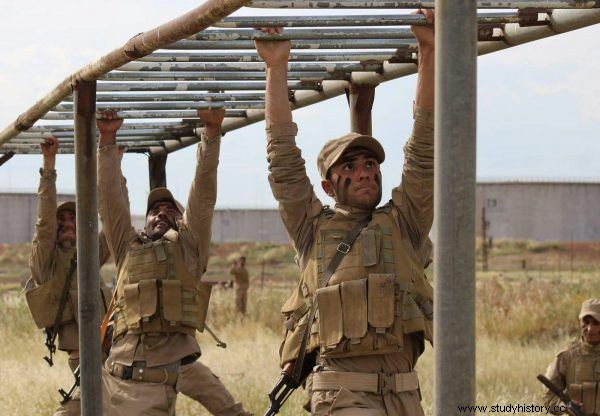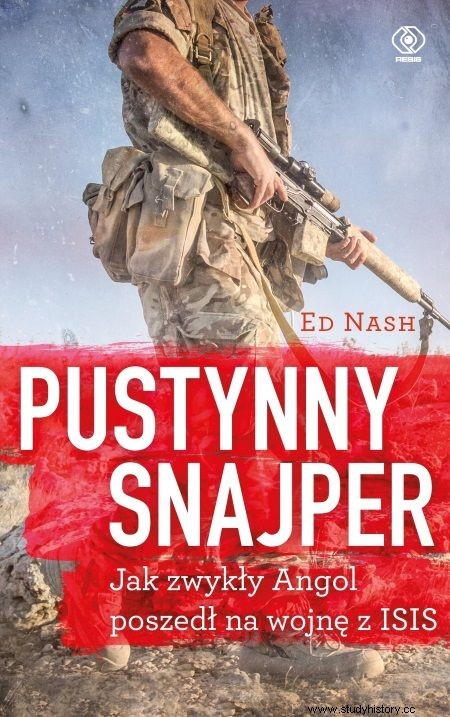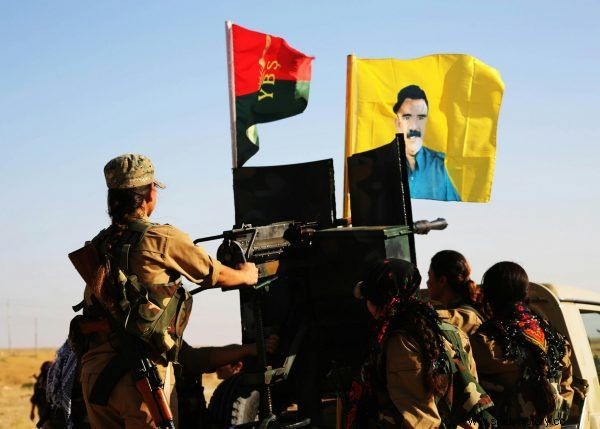Armed to the teeth, perfectly trained and boundlessly determined? If there is such a picture of people fighting terrorists in your head, you are ... wrong. Their training can only be called murderous because their level of knowledge makes them at best cannon fodder.
British volunteer Ed Nash, who came to the front of the fight against ISIS, had no specific plan. Before he arrived in Syria, he wandered around the world, he had no permanent address and no plan for life. When a brutal conflict broke out in the region, he was co-operating with a humanitarian organization operating in Burma. Upon hearing about the Battle of Kobane (which we have already described in another article), he decided to somehow support the Kurds fighting against Islamic State.
He arrived in northern Iraq with only contact information for someone who might put him in touch with Kurdish soldiers and a phone number for someone who was supposed to explain to the taxi driver where he should go in a language the locals could understand. however, already at the airport, rude to all officials greeted him kindly. And they immediately thanked him for coming to fight for them.
After several days of waiting, Nash, along with several other volunteers, was taken to a mountain training camp, where he began to acclimatize among the Kurds and learn the language. He also received the nickname "Botan" (from the name of the river flowing in the region). It was then that he and his new colleagues learned, among other things, to always leave one bullet in the magazine of the pistol for themselves, or to carry a grenade detonating without delay. He knew that in the event of capture by ISIS, death was the better option. If he was caught alive, a show execution by beheading, broadcasted live, could await him.
Throw a stone at the tire and admire the grenade launcher
Before the actual training began, representatives of the YPG (Kurdish Universal Defense Units) signed an agreement with the volunteers. It contained arrangements such as that the organization would pay them to return home after at least six months of service, provide military training and learn the language. Volunteers also received uniforms. Then the science began, which Ed Nash ironically describes in his book "Desert Sniper" :
The so-called training took two weeks. We were given a Kalashnikov without ammunition to practice the drill with them and put up posts during the night watch service. There was also shooting:six missiles from the AK Kbk and three from the PKM. It was also allowed to throw stones at the tire, which was to prepare us to throw a grenade . Even what an RPG looks like, a manual anti-tank grenade launcher. Literally. A Kurd picked him up and said, "This is an RPG."

Training of YPG members (photo Kurdishstruggle, license CC BY 2.0)
Among the volunteers who went to fight the Islamic State were many veterans of various armies. They watched with horror what the training was like. They knew that the fighters with ISIS were in for a murderous fight. More than once, it was supposed to involve taking villages and cities from house to house, so learning the tactics of cleaning buildings, for example, was worth its weight in gold. To save the lives of other recruits, they got involved and shared their own knowledge.
The most important, however, was the issue of acquiring the basics of the so-called battlefield medicine. Due to the lack of first aid training, for example, in the event of stepping on a mine or detonation of cottage explosives, most soldiers died. They were just bleeding out while their brothers-in-arms watched helplessly as the slime soaked into the sand. They just didn't know what to do. Fortunately, an ex-military doctor was among the volunteers who taught the rest of the basics.
How to train a sniper? In practice!
Nash eventually ended up in the flight brigade sniper fleet. Interestingly, most of the senior YPG commanders passed through this unit and was considered a forge of cadres. After being among the snipers, the British, who did not know how to use a sniper rifle, counted on solid training.

When the study began, he was disappointed to say the least. Instead of hours at the shooting range, learning about weapons and dismantling and assembling rifles on time, he underwent ... political indoctrination on the example of the theory of Abdullah Öcalan, one of the most important Kurdish leaders. Considering the fact that the fighting Kurds believed in the power of moral superiority over the enemy, it is hardly surprising. However, proper combat training was just pathetic:
Our drills were so that every other day we walked to an abandoned village in the morning, where we held positions and fired maybe five shots at targets between fifty and seven hundred meters away. Then we returned to the barracks. Regardless of whether we were shooting with the M16 or with an enemy, the instructors did not help us in any way, although of course they expected us to hit the target. Because of this, almost all of them missed or had poor results. Welat, a former soldier and security guard, wrung his hands and repeated that we should shoot during exercises with our own weapons, because we will not achieve anything. The locals ignored it.
Besides, Kurds often seemed to suffer from selective deafness when foreign veterans pointed out something to them. A perfect example is the story of the "sniper button" that writes about Nash in "Desert Sniper" . Already in Vietnam, it was discovered that the early models of the M16 rifles, when dirty, had problems feeding their ammunition.

Jezydki fighting for the YPG. Abdullah Öcalan on the yellow flag (Photo
Kurdishstruggle
, CC BY 2.0 license)
The manufacturer found a way to do this by installing a push button on the side. As it turns out, YPG soldiers fighting ISIS were convinced that it was a "sniper button" that allowed them to shoot further and more accurately when pressed. One of them came up with the idea, and it was repeated in training soon after, and the belief became widespread.
Volunteers who underwent a residual combat course ended up at the front. On the front lines, they had to complete their "education" very quickly. It meant learning by doing. This is also how Nash was educated, who in order to survive had to use every opportunity to improve his skills. As he wrote in "Desert Sniper" , one time he engaged in a firefight with a fighter far away, shooting at him with the Home Army:
Wasted ammo only. I fired a few more times, treating it more like training, while he used up a few magazines. For my part, it was not a waste of ammunition. Simply put, dragunov exercises were strictly forbidden and similar occasions should be seized.
Source:
Trivia is the essence of our website. Short materials devoted to interesting anecdotes, surprising details from the past, strange news from the old press. Reading that will take you no more than 3 minutes, based on single sources. This particular material is based on the book:
- Ed Nash, Desert Sniper. How ordinary Angol went to war with ISIS , Rebis 2019 Publishing House.
Get to know the extraordinary story of a British man fighting in Syria:

